Are similar patterns to be seen in the development of different technological objects? Is it possible to identify such patterns, where applicable, in different periods? Which factors can be taken into account in explaining processes of technological development? What role does knowledge play in the development of technological objects, and what influence do such developments, for their part, have on knowledge? It is against the background of these general questions that the Topoi Junior Research Group “Between Knowledge and Innovation” launches its study of balances with arms of unequal length.
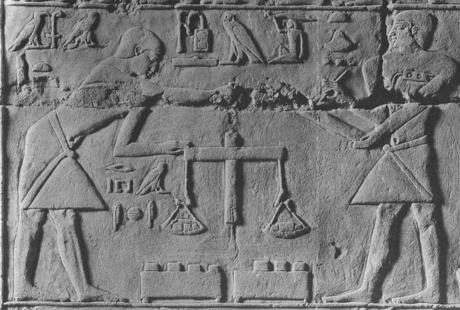
Fig. 2: One of the oldest surviving images of an equal-arm balance. Egyptian tomb, VI Dynasty, after ca. 2300 BC. (OIP 31, plate 30, Copyright The Oriental Institute of The University of Chicago).
The first evidence of scales and weights dates back to circa 3000 BCE, in Egypt. The concept of weighing spread quickly and had an immediate impact on the Bronze Age world. Balances continued to evolve, but their basic principle remained the same for millennia: the weight (or more precisely, the mass) of the item to be weighed on one arm of the balance is compensated (or, literally, “balanced”) by the identical weight of one or more standardized balance weights placed on the other arm of equal length. Balances realizing this principle are referred to as “equal-arm balances” or “equal-arm lever balances.”
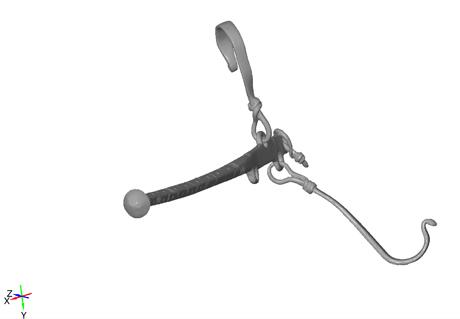
Fig. 3: 3-D model of a Roman steelyard from the Landesmuseum Bonn (without Inv. No.). Click on the illustration to view the interactive model. Measuring the scales with their many markings is extremely time-consuming. Now, instead of working with the object in question directly on site, it is possible to use a digital model. The degree of precision is rigorous, and the method does not affect the objects themselves, many of which are quite fragile. The project will make the models freely available.
Not until 2500 years later did a new, completely different type of lever balance make its appearance. In the case of this balance with arms of unequal length (“unequal-arm balance,” for short), loads of different weight are no longer compensated by different standardized balance weights but rather by just one single counterweight. With this type of scale, equilibrium—that is, a horizontal position of the balance beam—is achieved by means of adjusting the length of the arm. Changes of weight are in this case thus not compensated by corresponding changes of weight but by changes of length.
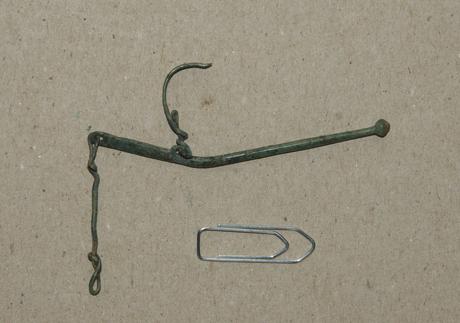
Fig. 4: Miniature Roman steelyard in the Römisch-Germanisches Museum, Cologne (Inv. No. 884; photograph: Jochen Büttner). The dimensions of Roman steelyards suited to their respective uses. Thus in addition to extremely large steelyards, we find also very small examples, such as the one shown here. Precisely what kind of goods were measured by this tiny balance remains an open question for research.
To the modern observer, this is no longer something to marvel at. The operation of the unequal-arm balance can be described by the law of the lever. Equilibrium is obtained when the arms of the lever are in inverse proportion to the weights that are applied to them. Should it therefore be assumed that insight into the law of the lever was what made it possible for such balances to be built? Research by Department I has shown that the opposite is more likely to be the case. The first mention of an unequal-arm balance is found in a comedy from the year 421 BCE by the Athenian playwright Aristophanes. The first known formulation of the law of the lever, however, dates to the next century. There is in fact much to suggest that it was the existence of unequal-arm balances—which so clearly embody the law of the lever—that first stimulated the formulation of the law.
![Marble relief, circa 130 CE (Dresden, Skulpturensammlung [Albertinum]) Inv. No. 415. Photograph: DAI).](/sites/default/files/styles/content_central_image/public/migrated/img4_32.jpg?itok=Aq6HarTN)
Fig. 5: Marble relief, circa 130 CE (Dresden, Skulpturensammlung [Albertinum]) Inv. No. 415. Photograph: DAI). Compared to equal-arm balances, unequal-arm balances have several construction-related disadvantages but also many advantages. As no set of standardized reference weights is needed, they are well suited to transport, for example. It appears that large specimens in particular were also sometimes set up as stationary devices, as on the relief shown here, which depicts a Roman butcher at work.
Unequal-arm balances, practical experience with them, and the knowledge that derived from this experience thus served as midwife to the birth of the science of mechanics. Over the next two thousand years, the development of theoretical knowledge of mechanics would stay closely bound to questions relating to unequal-arm balances. The balances themselves—and the practical knowledge associated with them—also continued to develop, although they did so largely independently of theoretical knowledge. For instance, the balances that reached the Islamic world via Byzantium in the eighth century (to become the subject of an unprecedented genre of texts combining theoretical and practical knowledge) have relatively little to do with the type of scale mentioned by Aristophanes.

Fig. 6: Steelyard from Egypt or Syria, ninth to tenth century (Benaki Museum, Athens. Inv. No. 13275). In imperial Rome and during late antiquity, scales with arms of unequal length were constructed in the thousands along the model of the Roman steelyard. The individual components, such as the rotating design of the hanging scale pan, changed over time, however. The balance depicted here, whose scale is furnished with Arabic characters, shows how an originally Roman technology found its way into the Islamic cultural realm.
Despite its importance for the birth and subsequent molding of the science of mechanics, there is a dearth of research on the emergence of the unequal-arm balance, the dynamics of its development, and related technological-practical knowledge in antiquity and late antiquity. This is remarkable considering the fact that the unequal-arm balance was the most widespread and most widely used mechanical precision tool at the time. The number of preserved scales is correspondingly high. It is precisely the large number of preserved and relatively well documented artifacts, supplemented by textual and iconographic sources, that makes the unequal-arm balance a suitable model for a paradigmatic study of the origin, dynamics and development of technological innovations and the cultural conditions and effects of these innovations in antiquity and late antiquity.
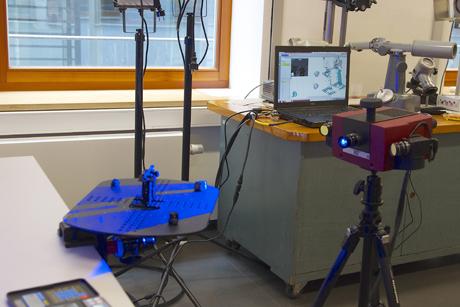
Fig. 7: 3-D rendering of a steelyard in the Landesmuseum Bonn (photograph: Jochen Büttner). With the help of a 3-D scanner (right), the balances can be recorded with accuracy up to the hundredth millimeter range. Subsequent analysis of the object’s geometry is carried out using the 3-D model calculated from the scanned data.
Using the unequal-arm balance as an example, the project’s goal is, on the one hand, to model an innovation process based on existing material evidence and, on the other hand, to interpret it by reconstructing the historical circumstances under which it arose. We direct special attention toward reconstructing the practical knowledge that resulted from the experience of using this instrument as well as the knowledge that was implemented in producing these scales. What did this knowledge consist of? Who were its agents? How was it disseminated? And how did it evolve during the period? Only when these and similar questions can be answered will it be possible to understand the development of mechanics as the result of a complex interplay of theoretical and practical knowledge.
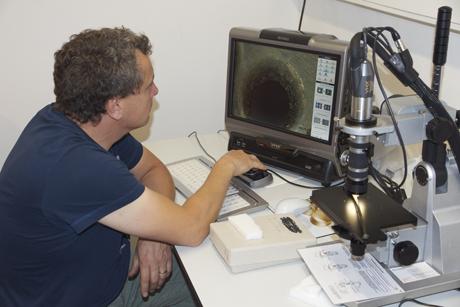
Fig. 8: Frank Willer from the department for metal restoration at the Landesmuseum Bonn inspects a Roman steelyard under a Keyence microscope (photograph: Jochen Büttner). The finest traces of the original workmanship are visible under the microscope, which can give information about the process of production. It can thus for instance be determined whether the eyelets on a balance—which must be placed with the utmost precision—were originally included in the casting process or whether they were subsequently drilled and scratched out with an awl.
It can be assumed that the evolution of the unequal-arm balance is typical of other technological innovation processes in antiquity and late antiquity (as well). For that reason, the questions addressed by the project point far beyond the historical understanding of the development of the unequal-arm balance and the specific knowledge connected to it. Applying the models and concepts taken from current innovation research to antiquity and late antiquity, as the project intends to do, should thus also lead to a deeper understanding of processes of technological development in this period, while simultaneously contributing to the development of a more general theory of innovation.
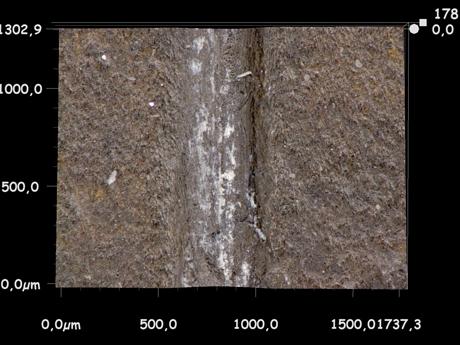
Fig. 9: Detail under the Keyence microscope showing the markings on the load arm of a balance (without Inv. No.) in the Landesmuseum Bonn (photograph: Frank Willer). As indicated by the clearly visible remains of a tin coating in the filed groove, the marking was not essential to the production process, as had been originally believed, but was rather part of the ornamentation of the balance’s beam.
